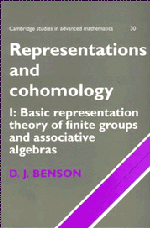Book contents
Chapter 1 - Background material from rings and modules
Published online by Cambridge University Press: 26 January 2010
Summary
Group representations are often studied as modules over the group algebra (see Chapter 3), which is a finite dimensional algebra in case the coefficients are taken from a field, and a Noetherian ring if integer or p-adic coefficients are used. Thus we begin with a rather condensed summary of some general material on rings and modules. Sources for further material related to Chapters 1 and 3 are Alperin, Curtis and Reiner, Feit and Landrock. We return for a deeper study of modules over a finite dimensional algebra in Chapter 4.
Throughout this chapter, Λ denotes an arbitrary ring with unit, and M is a (left) Λ-module.
The Jordan–Hölder theorem
Definition 1.1.1. A composition series for a Λ-module M is a series of submodules
with Mi/Mi–1 irreducible.
A module M is said to satisfy the descending chain condition (D.C.C.) on submodules if every descending chain of submodules eventually stops, and the ascending chain condition (A.C.C.)if every ascending chain of submodules eventually stops. A module satisfying A.C.C. on submodules is said to be Noetherian.
Lemma 1.1.2 (Modular law). If A and B ⊇ C are submodules of M then
Proof. Clearly C + (A ∩ B) ⊆ (C + A) ∩ B. Conversely if b = c + a ∈ (C + A)∩ B then a = b – c ∈ A ∩ B and so b ∈ C + (A ∩ B).
- Type
- Chapter
- Information
- Representations and Cohomology , pp. 1 - 20Publisher: Cambridge University PressPrint publication year: 1991



